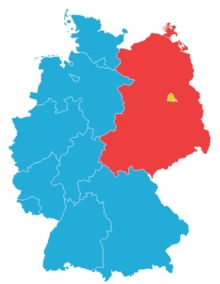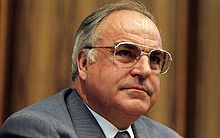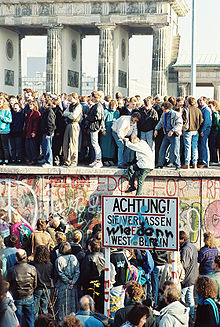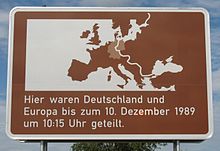- German reunification
-
This article is about the 1990 German reunification. For the 1871 German Empire, see Unification of Germany.
German reunification (German: Deutsche Wiedervereinigung) was the process in 1990 in which the German Democratic Republic (GDR/East Germany) joined the Federal Republic of Germany (FRG/West Germany), and when Berlin reunited into a single city, as provided by its then Grundgesetz constitution Article 23. The start of this process is commonly referred by Germans as die Wende (The Turning Point). The end of the unification process is officially referred to as German unity (German: Deutsche Einheit), celebrated on 3 October (German Unity Day).[1]
Contents
The East German regime started to falter in May 1989, when the removal of Hungary's border fence opened a hole in the Iron Curtain. It caused an exodus of thousands of East Germans fleeing to West Germany and Austria via Hungary. The Peaceful Revolution, a series of protests by East Germans, led to the GDR's first free elections on 18 March 1990, and to the negotiations between the GDR and FRG that culminated in a Unification Treaty,[1] whilst negotiations between the GDR and FRG and the four occupying powers produced the so-called "Two Plus Four Treaty" (Treaty on the Final Settlement with Respect to Germany) granting full sovereignty to a unified German state, whose two halves had previously still been bound by a number of limitations stemming from their post-WWII status as occupied regions. The united Germany remained a member of the European Community (later the European Union) and of NATO.
Naming
There is debate as to whether the events of 1990 should be properly referred to as a "reunification" or a "unification". Proponents[specify] of the former use the term in contrast with the initial unification of Germany in 1871. Also when the Saarland joined the West German Federal Republic of Germany on 1 January 1957, this was termed the Small Reunification. Popular parlance, which uses "reunification", is deeply affected by the 1989 opening of the Berlin Wall (and the rest of the inner German border) and the physical reunification of the city of Berlin (itself divided only since 1945). Others,[who?] however, argue that 1990 represented a "unification" of two German states into a larger entity which, in its resulting form, had never before existed (see History of Germany).
For political and diplomatic reasons, West German politicians carefully avoided the term "reunification" during the run-up to what Germans frequently refer to as die Wende. The official[1] and most common term in German is "Deutsche Einheit" (in English "German unity"). German unity is the term that Hans-Dietrich Genscher used in front of international journalists to correct them when they asked him about "reunification" in 1990.
After 1990, the term "die Wende" became more common. The term generally refers to the events (mostly in Eastern Europe) that led up to the actual reunification; in its usual context, this term loosely translates to "the turning point", without any further meaning. When referring to the events surrounding unification, however, it carries the cultural connotation of the time and the events in the GDR that brought about this "turnaround" in German history. However, civil rights activists from Eastern Germany rejected the term Wende as it was introduced by SED's Secretary General Egon Krenz.[2]
Precursors to reunification
Further information: Iron_Curtain#Fall_of_the_Iron_Curtain, Revolutions of 1989, Dissolution of the Soviet Union, and European integrationIn 1945, the Third Reich ended in defeat and Germany was divided into two separate countries, with the east controlled as part of the Communist Soviet Bloc and the west aligned to Capitalist Europe (which formed into the European Community), including a division in military alliance that formed into the Warsaw Pact and NATO, respectively. The capital city of Berlin was divided into four occupied sectors of control, under the Soviet Union, the United States, the United Kingdom and France. Germans lived under such imposed divisions throughout the ensuing Cold War.
Into the 1980s, the Soviet Union experienced a period of economic and political stagnation, and they correspondingly decreased intervention in Eastern Bloc politics. In 1987, US President Ronald Reagan gave a speech at Brandenburg Gate challenging Soviet leader Mikhail Gorbachev to "tear down this wall" that had separated Berlin. The wall had stood as an icon for the political and economic division between East and West, a division that Churchill had referred to as the "Iron Curtain". In early 1989, under a new era of Soviet policies of glasnost (openness), perestroika (economic restructuring) and taken to even more progressive levels by Gorbachev, the Solidarity movement took hold in Poland. Further inspired by other images of brave defiance, a wave of revolutions swept throughout the Eastern Bloc that year. In May 1989, Hungary removed their border fence and thousands of East Germans escaped to the West. The turning point in Germany, called "Die Wende", was marked by the "Peaceful Revolution" leading to the removal of the Berlin Wall with East and West Germany subsequently entering into negotiations toward eliminating the division that had been imposed upon Germans more than four decades earlier.
Process of reunification
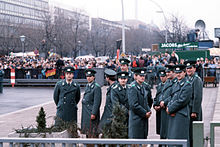 Police officers of the East German Volkspolizei wait for the official opening of the Brandenburg Gate on 22 December 1989.
Police officers of the East German Volkspolizei wait for the official opening of the Brandenburg Gate on 22 December 1989.
On 28 November 1989--two weeks after the fall of the Berlin Wall--West German Chancellor Helmut Kohl announced a 10-point program calling for the two Germanies to expand their cooperation with the view toward eventual reunification.[3]
Initially, no timetable was proposed. However, events rapidly came to a head in early 1990. First, in March, the Party of Democratic Socialism--the former Socialist Unity Party of Germany--was heavily defeated in East Germany's first honest elections. A grand coalition was formed under Lothar de Maizière, leader of the East German wing of Kohl's Christian Democratic Union, on a platform of speedy reunification. Second, East Germany's economy and infrastructure underwent a swift and near-total collapse. While East Germany had long been reckoned as having the most robust economy in the Soviet bloc, the removal of Communist discipline revealed the ramshackle foundations of that system. The East German mark had been practically worthless outside of East Germany for some time before the events of 1989-90, further magnifying the problem.
Discussions immediately began for an emergency merger of the Germanies' economies. On 18 May 1990, the two German states signed a treaty agreeing on monetary, economic and social union. This came into force on 1 July 1990, with the Deutsche Mark replacing the East German mark as the official currency of East Germany. The Deutsche Mark had a very high reputation among the East Germans and was considered stable.[4] While the GDR transferred its financial policy sovereignty to West Germany, the West started granting subsidies for the GDR budget and social security system.[5] At the same time many West German laws came into force in the GDR. This created a suitable framework for a political union by diminishing the huge gap between the two existing political, social, and economic systems.[5]
A reunification treaty between West Germany and the GDR was negotiated in mid-1990, signed on 31 August of that year and finally approved by large majorities in the legislative chambers of both countries on 20 September 1990.[6] After that last step Germany was officially united at 00:00 CET on 3 October 1990. East Germany joined the Federal Republic as the five states of Brandenburg, Mecklenburg-Vorpommern, Saxony, Saxony-Anhalt and Thuringia. These states had been the five original states of East Germany, but had been abolished in 1952 in favour of a centralised system. As part of the 18 May treaty, the five East German states had been reconstituted on 23 August. At the same time, East and West Berlin reunited into one city, which became a city-state along the lines of the existing city-states of Bremen and Hamburg.
The process chosen was one of two options implemented in the West German constitution (Basic Law) of 1949. Via that document's (then-existing) Article 23, any new Länder (German federative states), could adhere to the Basic Law by a simple majority vote. Thus the states' parliaments would vote in for their adhesion. The initial eleven joining states of 1949 comprised the Trizone and West Berlin. However the latter was legally inhibited by Allied objection due to the status of the city as a quadripartite allied occupation area.[7] In 1957 the Saar Protectorate joined West Germany under the Article 23 procedure as Saarland. As the five refounded eastern German states formally joined the Federal Republic using the Article 23 procedure, the area in which the Basic Law was in force simply extended to include them.[8] The alternative would have been for East Germany to join as a whole along the lines of a formal union between two German states that then would have had to, amongst other things, create a new constitution for the newly established country.
Under the model that was chosen, however, the territory of the former German Democratic Republic was simply incorporated into the Federal Republic of Germany, and accordingly the Federal Republic of Germany, now enlarged to include the Eastern States, continued legally to exist under the same legal personality that was founded in May 1949.
Thus, the reunification was not a merger that created a third state out of the two, but an incorporation, by which West Germany absorbed East Germany. Thus, on Unification Day, October 3, 1990, the German Democratic Republic ceased to exist, giving way to five new Federal States, and East and West Berlin were also unified as a single city-state, forming a sixth new Federal State. The new Federal States immediately became parts of the Federal Republic of Germany, so that it was enlarged to include the whole territory of the former East Germany and Berlin.
The practical result of that model is that the now expanded Federal Republic of Germany continued to be a party to all the treaties it had signed prior to the moment of reunification, and thus continued the same membership of the U.N., NATO, the European Communities, etc.; also, the same Basic Law and the same laws that were in force in the Federal Republic continued automatically in force, but now applied to the expanded territory.
To facilitate this process and to reassure other countries, some changes were made to the "Basic Law" (constitution). Article 146 was amended so that Article 23 of the current constitution could be used for reunification. After the five "New Länder" of East Germany had joined, the constitution was amended again to indicate that all parts of Germany are now unified. Article 23 was rewritten and it can still be understood as an invitation to others (e.g. Austria) to join, although the main idea of the change was to calm fears in (for example) Poland, that Germany would later try to rejoin with former eastern territories of Germany that were now Polish or parts of other countries in the East. The changes effectively formalised the Oder-Neisse line as Germany's permanent eastern border. These amendments to the Basic Law were mandated by Article I, section 4 of the Two Plus Four Treaty.[9]
While the Basic Law was modified rather than replaced by a constitution as such, it still permits the adoption of a formal constitution by the German people at some time in the future.
To commemorate the day that marks the official unification of the former East and West Germany in 1990, 3 October has since then been the official German national holiday, the Day of German Unity (Tag der deutschen Einheit). It replaced the previous national holiday held in West Germany on 17 June commemorating the Uprising of 1953 in East Germany and the national holiday on 7 October in the GDR.[5]
Foreign opposition
For decades, Germany's allies had stated their support for reunification; Israeli Prime Minister Yitzhak Shamir, who speculated that a country that "decided to kill millions of Jewish people" in the Holocaust "will try to do it again", was one of the few world leaders to publicly oppose it. As reunification became a realistic possibility, however, significant NATO and European opposition emerged in private.[10]
Britain and France
Before the fall of the Berlin Wall, British Prime Minister Margaret Thatcher told Soviet President Mikhail Gorbachev that neither the United Kingdom nor Western Europe wanted the reunification of Germany. Thatcher also clarified that she wanted the Soviet leader to do what he could to stop it, telling Gorbachev "We do not want a united Germany".[11] Although she welcomed East German democracy, Thatcher worried that a rapid reunification might weaken Gorbachev,[12] and favoured Soviet troops staying in East Germany as long as possible to act as a counterweight to a united Germany.[10]
Thatcher, who carried in her handbag a map of Germany's 1937 borders to show others the "German problem", feared that its "national character", size, and central location in Europe would cause the nation to be a "destabilizing rather than a stabilizing force in Europe".[12] In December 1989, she warned fellow European Community leaders at a Strasbourg, France summit Kohl attended, "We defeated the Germans twice! And now they're back!"[13][10] Although Thatcher had stated her support for German self-determination in 1985,[12] she now argued that Germany's allies had only supported reunification because they had not believed it would ever happen.[10] Thatcher favoured a transition period of five years for reunification, during which the two Germanys would remain separate states. Although she gradually softened her opposition, as late as March 1990 Thatcher summoned historians and diplomats to a seminar at Chequers[12] to ask "How dangerous are the Germans?"[13] and the French ambassador in London reported that Thatcher had told him, "France and Great Britain should pull together today in the face of the German threat."[14][15]
Similarly, a representative of French President François Mitterrand reportedly told an aide to Gorbachev, "France by no means wants German reunification, although it realises that in the end it is inevitable."[11] At the Strasbourg summit, Mitterrand and Thatcher discussed the fluidity of Germany's historical borders.[10] On 20 January 1990, Mitterrand told Thatcher that a unified Germany could "make more ground than even Hitler had".[14] He predicted that "bad" Germans would reemerge,[13] who might seek to regain former German territory lost after World War II[12] and would likely dominate Hungary, Poland, and Czechoslovakia, leaving "only Romania and Bulgaria for the rest of us". The two leaders saw no way to prevent reunification, however, as "None of us was going to declare war on Germany".[10] Mitterrand recognized before Thatcher that reunification was inevitable and adjusted his views accordingly; unlike her, he was hopeful that participation in a single currency[12] and other European institutions could control a united Germany. Mitterrand still wanted Thatcher to publicly oppose unification, however, to obtain more concessions from Germany.[13]
The rest of Europe
Other European leaders' opinion of reunification was "icy". Italy's Giulio Andreotti warned against a revival of "pan-Germanism", and the Netherlands' Ruud Lubbers questioned the German right to self-determination. They shared Britain and France's concerns over a return to German militarism and the economic power of a reunified nation. The consensus opinion was that reunification, if it must occur, should not occur until at least 1995 and preferably much later.[10]
The four powers
“ The United States — and President George H. W. Bush — recognized that Germany had gone through a long democratic transition. It had been a good friend, it was a member of NATO. Any issues that had existed in 1945, it seemed perfectly reasonable to lay them to rest. For us, the question wasn't should Germany unify? It was how and under what circumstances? We had no concern about a resurgent Germany... ” —Condoleezza Rice, Special Assistant to the President for National Security Affairs[16]
The victors of World War II—the United States, the Soviet Union, the United Kingdom, and France, comprising the Four-Power Authorities—retained authority over Berlin, such as control over air travel and its political status. The Soviet Union sought early to use reunification as a way to push Germany out of NATO into neutrality, removing nuclear weapons from its territory. West Germany interpreted a 21 November 1989 diplomatic message on the topic, however, as meaning that only two weeks after the Wall's collapse the Soviet leadership already anticipated reunification. This belief, and the worry that his rival Genscher might act first, encouraged Kohl on November 28 to announce a detailed reunification plan (10-Point Plan). While his speech was very popular within West Germany Kohl's speech caused concern among other European governments, with whom he had not discussed the plan.[10]
The Americans did not share the Europeans' and Russians' historical fears over German expansionism, but wished to ensure that Germany would stay within NATO. In December 1989, the administration of President George H. W. Bush made a united Germany's continued NATO membership a requirement for supporting reunification. Kohl agreed, although less than 20% of West Germans supported remaining within NATO; he also wished to avoid a neutral Germany, as he believed that would destroy NATO, cause the United States and Canada to leave Europe, and Britain and France would form an alliance. The United States increased its support of Kohl's policies, as it feared that otherwise Oskar Lafontaine, a critic of NATO, might become Chancellor.[10]
Horst Teltschik, Kohl's foreign policy advisor, later recalled that Germany would have paid "100 billion deutschmarks" had the Soviets demanded it. The USSR did not make such great demands, however, with Gorbachev stating in February 1990 that "The Germans must decide for themselves what path they choose to follow". In May 1990 he repeated his remark in the context of NATO membership while meeting Bush, amazing both the Americans and Germans.[10]
Conclusion
During a NATO-Warsaw Pact conference in Ottawa, Canada, Genscher persuaded the four powers to treat the two Germanys as equals instead of defeated junior partners, and for the six nations to negotiate alone. Although the Dutch, Italians, Spanish, and other NATO powers opposed such a structure, which meant that the alliance's boundaries would change without their participation, the six nations began negotiations in March 1990. After Gorbachev's May agreement on German NATO membership, the Soviets further agreed that Germany would be treated as an ordinary NATO country, with the exception that former East German territory would not have foreign NATO troops or nuclear weapons. In exchange, Kohl agreed to reduce the sizes of both Germanys' militaries, renounce weapons of mass destruction, and accept the postwar Oder-Neisse line as Germany's eastern border. In addition, Germany agreed to pay about 55 billion deutschmarks to the Soviet Union in gifts and loans, the equivalent of eight days of the West German GDP.[10]
Mitterrand agreed to reunification in exchange for a commitment from Kohl to the European Economic and Monetary Union.[17] The British insisted to the end, against Soviet opposition, that NATO be allowed to hold maneuvers in the former East Germany. After the Americans intervened,[10] both the UK and France ratified the Treaty on the Final Settlement with Respect to Germany in September 1990, thus finalizing the reunification for purposes of international law. Thatcher later wrote that her opposition to reunification had been an "unambiguous failure".[12]
Aftermath
On 14 November 1990, the united Germany and Poland signed the German–Polish Border Treaty, finalizing Germany's boundaries as permanent along the Oder-Neisse line, and thus, renouncing any claims to Silesia, East Brandenburg, Farther Pomerania, and territories of the former province of East Prussia.[18] The treaty also granted certain rights for political minorities on either side of the border.[19] The following month, the first all-German free elections since 1932 were held, resulting in an increased majority for the coalition government of Chancellor Helmut Kohl.
On 15 March 1991, the Treaty on the Final Settlement With Respect to Germany entered into force, putting an end to the remaining limitations on German sovereignty that resulted from the post WWII arrangements.
Inner reunification
Main article: New federal statesVast differences between the former East Germany and West Germany (for example, in lifestyle, wealth, political beliefs and other matters) remain, and it is therefore still common to speak of eastern and western Germany distinctly. The eastern German economy has struggled since unification, and large subsidies are still transferred from west to east. The former East Germany area has often been compared to the underdeveloped Southern Italy and the Southern United States during Reconstruction after the American Civil War. While the East German economy has recovered recently, the differences between East and West remain constant.[20][21]
 Reenacting noted Alfred Eisenstaedt V-J Day photo at 12:01 A.M. on Reunification night in Cologne, Germany.
Reenacting noted Alfred Eisenstaedt V-J Day photo at 12:01 A.M. on Reunification night in Cologne, Germany.
Politicians and scholars have frequently called for a process of "inner reunification" of the two countries and asked whether there is "inner unification or continued separation".[22] "The process of German unity has not ended yet", proclaimed Chancellor Angela Merkel, who grew up in East Germany, in 2009.[23] Nevertheless, the question of this "inner reunification" has been widely discussed in the German public, politically, economically, culturally, and also constitutionally since 1989.
Politically, since the fall of the Wall, the successor party of the former East German socialist state party has become a major force in German politics. It was renamed PDS, and, later, merged with the Western leftist party WASG to form the party Die Linke (The Left).[24]
Constitutionally, the Basic Law (Grundgesetz), the West German constitution, provided two pathways for a unification, the first including an implementation of the constitution in the East, the second the implementation of a new all-German constitution, safeguarded by a popular referendum. While the former option was chosen as the most feasible one, the latter option was partly regarded as a means to foster the "inner reunification".[25][26]
A public manifestation of coming to terms with the past (Vergangenheitsbewältigung) is the existence of the so-called Birthler-Behörde, the Federal Commissioner for the Stasi Archives, which collects and maintains the files of the East German security apparatus.[27]
The economic reconstruction of former Eastern Germany following the reunification required large amounts of public funding which turned some areas into boom regions, although overall unemployment remains higher than in the former West.[28] Reunification did, however, lead to a large rise in the average standard of living in former Eastern Germany. Between 1990 and 1995, gross wages in the east rose from 35% to 74% of western levels, while pensions rose from 40% to 79%.[29]:209
In terms of media usage and reception, the country remains partially divided especially among the older generations. Mentality gaps between East and West persist, but so does sympathy.[23] Additionally, the daily-life exchange of Easterners and Westerners is not so large as expected.[30][31] Young people's knowledge of the former East Germany is very low.[32] Some people in Eastern Germany engage in "Ostalgia", which is a certain nostalgia for the time before the wall came down.[33]
Today, there are several prominent East Germans shaping the image of Germany at home and abroad, including Kurt Masur, Michael Ballack, Katarina Witt, and Angela Merkel.
See also
- History of Germany since 1945
- Reunification
- Stalin Note – 1952 German reunification proposal
- Transitology
- Goodbye Lenin!
References
- ^ a b c Vertrag zwischen der Bundesrepublik Deutschland und der Deutschen Demokratischen Republik über die Herstellung der Einheit Deutschlands (Einigungsvertrag) Unification Treaty signed by the Federal Republic of Germany and the German Democratic Republic in Berlin on 31 August 1990 (official text, in German).
- ^ Krenz speech of October 18, 1989 in the German radio archive
- ^ Helmut Kohl's 10-Point Plan for German Unity
- ^ German Unification Monetary union. Cepr.org (1990-07-01). Retrieved on 2010-10-19.
- ^ a b c Embassy of the Federal Republic of Germany London – A short history of German reunification. London.diplo.de. Retrieved on 2010-10-19.
- ^ Opening of the Berlin Wall and Unification: German History. Germanculture.com.ua. Retrieved on 2010-10-19.
- ^ However, in many fields it functioned de facto as if it were a component State of West Germany.
- ^ Germany Today – The German Unification Treaty – travel and tourist information, flight reservations, travel bargains, hotels, resorts, car hire. Europe-today.com. Retrieved on 2010-10-19.
- ^ "File:Zwei-Plus-Vier-Vertrag.pdf". http://commons.wikimedia.org/wiki/File:Zwei-Plus-Vier-Vertrag.pdf.
- ^ a b c d e f g h i j k l Wiegrefe, Klaus (2010-09-29). "An Inside Look at the Reunification Negotiations". Der Spiegel. http://www.spiegel.de/international/germany/0,1518,druck-719848,00.html. Retrieved 2010-10-04.
- ^ a b "Thatcher told Gorbachev Britain did not want German reunification". Michael Binyon (London: Times). 11 September 2009. http://www.timesonline.co.uk/tol/news/politics/article6829735.ece. Retrieved 8 November 2009.
- ^ a b c d e f g Kundnani, Hans (2009-10-28). "Margaret Thatcher's German war". The Times. http://entertainment.timesonline.co.uk/tol/arts_and_entertainment/the_tls/article6893915.ece. Retrieved 2010-10-05.
- ^ a b c d Volkery, Carsten (2009-11-09). "The Iron Lady's Views on German Reunification/'The Germans Are Back!'". Der Spiegel. http://www.spiegel.de/international/europe/0,1518,648364,00.html. Retrieved 2010-10-05.
- ^ a b Anne-Laure Mondesert (AFP) (31 October 2009). "London and Paris were shocked by German reunification". Calgary Herald. http://www.calgaryherald.com/news/London+Paris+were+shocked+German+reunification/2168902/story.html. Retrieved 9 November 2009.
- ^ Peter Allen (2 November 2009). "Margaret Thatcher was 'horrified' by the prospect of a reunited Germany". Telegraph (London). http://www.telegraph.co.uk/news/worldnews/europe/germany/6480413/Margaret-Thatcher-was-horrified-by-the-prospect-of-a-reunited-Germany.html. Retrieved 9 November 2009.
- ^ "'I Preferred To See It as an Acquisition'". Der Spiegel. September 29, 2010. http://www.spiegel.de/international/world/0,1518,719444,00.html. Retrieved 2010-10-07.
- ^ Ben Knight (8 November 2009). "Germany's neighbors try to redeem their 1989 negativity". Deutsche Welle. http://www.dw-world.de/dw/article/0,,4861759,00.html. Retrieved 9 November 2009.
- ^ The territory of the League of Nations mandate of the Free City of Danzig, annexed by Poland in 1945 and comprising the city of Gdańsk (Danzig) and a number of neighbouring cities and municipalities, had never been claimed by any official side, because West Germany followed the legal position of Germany in its borders of 1937, thus before any Nazi annexations.
- ^ Poland Germany border - Oder Neisse. Polandpoland.com (1990-11-14). Retrieved on 2010-10-19.
- ^ Underestimating East Germany - Magazine. The Atlantic (2010-10-15). Retrieved on 2010-10-19.
- ^ After the fall 20 years ago this week the crumbling of the Berlin Wall began an empire s end. Anniston Star. Retrieved on 2010-10-19.
- ^ National identity in eastern Germany ... - Google Bücher. Books.google.com (1990-10-30). Retrieved on 2010-10-19.
- ^ a b (German) Umfrage: Ost- und Westdeutsche entfernen sich voneinander - Nachrichten Politik - WELT ONLINE. Welt.de. Retrieved on 2010-10-19.
- ^ (German) Partei des Demokratischen Sozialismus – Wikipedia. De.wikipedia.org. Retrieved on 2010-10-19.
- ^ Gastbeitrag: Nicht für die Ewigkeit - Staat und Recht - Politik. Faz.Net. Retrieved on 2010-10-19.
- ^ Aus Politik und Zeitgeschichte, Nr. 18 2009, 27.04.2009 - Das Grundgesetz - eine Verfassung auf Abruf?. Das-parlament.de. Retrieved on 2010-10-19.
- ^ DDR-Geschichte: Merkel will Birthler-Behörde noch lange erhalten - SPIEGEL ONLINE - Nachrichten - Politik. Spiegel.de (2009-01-15). Retrieved on 2010-10-19.
- ^ Facts about Germany: Society. Tatsachen-ueber-deutschland.de. Retrieved on 2010-10-19.
- ^ Parkes, K. Stuart (1997). Understanding contemporary Germany. Taylor & Francis. ISBN 0415141249. http://books.google.com/books?id=htUiBNqUAnYC&lpg=PP1&dq=understanding%20contemporary%20germany%20parkes&pg=PA209#v=onepage&q=74%25&f=false.
- ^ (German) Ostdeutschland: Das verschmähte Paradies | Campus | ZEIT ONLINE. Zeit.de (2008-09-29). Retrieved on 2010-10-19.
- ^ (German) Partnerschaft: Der Mythos von den Ost-West-Ehepaaren - Nachrichten Panorama - WELT ONLINE. Welt.de. Retrieved on 2010-10-19.
- ^ Politics and History - German-German History - Goethe-Institut. Goethe.de. Retrieved on 2010-10-19.
- ^ Zeitchik, Steven (7 October 2003). "German Ostalgie : Fondly recalling the bad old days". The New York Times. http://www.nytimes.com/2003/10/07/opinion/07iht-edzeitchik_ed3_.html?pagewanted=. Retrieved 3 May 2010.[dead link]
Further reading
- Charles S. Maier, Dissolution: The Crisis of Communism and the End of East Germany (Princeton University Press, 1997).
- Philip Zelikow and Condoleezza Rice, Germany Unified and Europe Transformed: A Study in Statecraft (Harvard University Press, 1995 & 1997).
Primary sources
- Jarausch, Konrad H., and Volker Gransow, eds. Uniting Germany: Documents and Debates, 1944-1993 (1994), primary sources in English translation
External links
- Germany's Eastern Burden: The Price of a Failed Reunification
- The End of East Germany
- German Embassy Publication, Infocus: German Unity Day
- The Unification Treaty (Berlin, 31 August 1990) website of European navigator
- An Inside Look at the Reunification Negotiations
Categories:- National unifications
- 20th century in Germany
- Germany–Soviet Union relations
- Revolutions of 1989
- 1990 in Germany
- German reunification
- 1990 in East Germany
Wikimedia Foundation. 2010.

